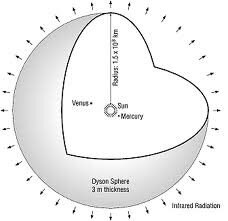For those of you who don’t know what a ‘Dyson Sphere’ is; it’s a giant globe constructed around a star to harness its energy like the one from ST: TNG episode “Relics”. In reality; to build one of these would take more resources than the planet earth could possibly provide. We would have to ‘disassemble’ the planet Jupiter to create a shell 2 to 3 meters thick to collect our suns energy with a diameter of twice the orbit of the earth. However a new theory uses a ‘Dyson-Harrop’ satellite to accomplish the same job but on a much smaller scale. Scientists from Washington State University are looking to design a new type of satellite that can collect the suns solar wind and harness its energy. The concept, designed by physicist Brooks Harrop, starts with a long metal wire loop pointed at the sun. This wire is charged to generate a cylindrical magnetic field that snags the electrons that make up half the solar wind. These electrons get funneled into a metal spherical receiver to produce a current, which generates the wire's magnetic field – making the system self-sustaining. Any current not needed for the magnetic field powers an infrared laser trained on satellite dishes back on Earth, designed to collect the energy. Meanwhile back on the satellite the current has been drained of its electrical energy by the laser – the electrons fall onto a ring-shaped sail, where incoming sunlight can re-energize them enough to keep the satellite in orbit around the sun. A relatively small Dyson-Harrop satellite using a 1-centimetre-wide copper wire 300 meters long, a receiver 2 meters wide and a sail 10 meters in diameter, sitting at roughly the same distance from the sun as the Earth, could generate 1.7 megawatts of power – enough for about 1000 family homes in the US. For more information on the Dyson-Harrop satellite concept please visit: http://journals.cambridge.org/action/displayAbstract?fromPage=online&aid=7451968
Zero

